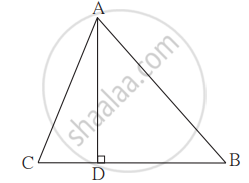Advertisements
Advertisements
प्रश्न
Find the Pythagorean triplet from among the following set of numbers.
4, 7, 8
उत्तर
It is known that, if in a triplet of natural numbers, the square of the biggest number is equal to the sum of the squares of the other two numbers, then the three numbers form a Pythagorean triplet.
The given set of numbers is (4, 7, 8).
The biggest number among the given set is 8.
82 = 64; 72 = 49; 42 = 16
Now, 16 + 49 = 65 ≠ 64
∴ 42 + 72 ≠ 82
Thus, (4, 7, 8) does not form a Pythagorean triplet.
संबंधित प्रश्न
Sides of triangle are given below. Determine it is a right triangle or not? In case of a right triangle, write the length of its hypotenuse. 7 cm, 24 cm, 25 cm
ABC is a triangle right angled at C. If AB = 25 cm and AC = 7 cm, find BC.
Find the side and perimeter of a square whose diagonal is 10 cm.
In ∆ABC, seg AD ⊥ seg BC, DB = 3CD.
Prove that: 2AB2 = 2AC2 + BC2

In the following Figure ∠ACB= 90° and CD ⊥ AB, prove that CD2 = BD × AD

If P and Q are the points on side CA and CB respectively of ΔABC, right angled at C, prove that (AQ2 + BP2 ) = (AB2 + PQ2)
In the right-angled ∆PQR, ∠ P = 90°. If l(PQ) = 24 cm and l(PR) = 10 cm, find the length of seg QR.
Find the Pythagorean triplet from among the following set of numbers.
3, 4, 5
In ΔABC, AD is perpendicular to BC. Prove that: AB2 + CD2 = AC2 + BD2
The perimeters of two similar triangles ABC and PQR are 60 cm and 36 cm respectively. If PQ = 9 cm, then AB equals ______.
